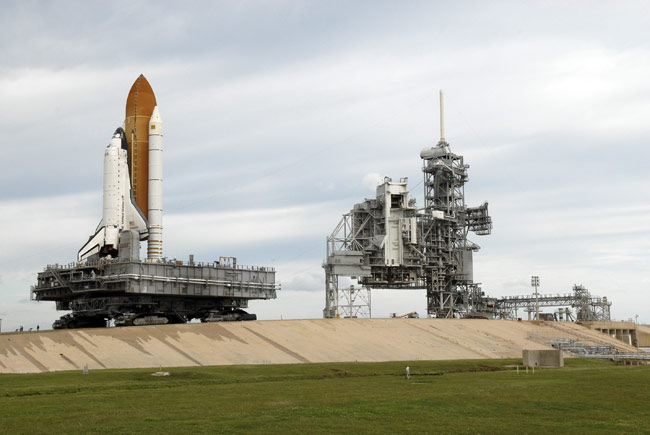Shuttle Endeavour Swaps Launch Pads for November Liftoff

This story was updated at 11:59 p.m. EDT.
The space shuttle Endeavour moved to a new launch pad Thursday to gear up for a supply run to the International Space Station next month.
The slow move began at 8:28 a.m. EDT (1228 GMT) at NASA's Kennedy Space Center (KSC) in Cape Canaveral, Fla., with engineers hauling Endeavour off its seaside Launch Pad 39B atop a 6 million-pound (2.7 million-kg) crawler carrier. The shuttle arrived at the nearby launch Pad 39A at 4:40 p.m. EDT (2040 GMT) and is due to launch to the space station on Nov. 14.
NASA calls the rare launch pad swap a "roll around." Endeavour was scheduled to make the move on Saturday, but the potential for lightning then prompted mission managers to switch launch pads earlier, NASA officials said.
"This is only the third time we've ever done a roll around," NASA spokesperson Candrea Thomas told SPACE.com from KSC. The trip took about eight hours at the carrier's plodding 1 mph (1.6 kph) pace.
Not since 1993 has a space shuttle moved between launch pads. It was Endeavour then too, moving from Pad 39A to 39B for its STS-61 mission. The shuttle Columbia also moved from 39A to 39B in 1990 for its STS-35 mission, Thomas said. NASA is currently using Pad 39A as its main shuttle launch site while converting the other site for the use of its future Ares I rocket and Orion shuttle successor.
Endeavour has spent weeks atop Launch Pad 39B on standby, where it was serving as a rescue craft for its sister ship Atlantis' planned launch to the Hubble Space Telescope.
Breaking space news, the latest updates on rocket launches, skywatching events and more!
Atlantis was slated to launch seven astronauts toward Hubble on Oct. 14 to overhaul the space telescope for the fifth and final time.
But that mission was delayed until next February or later after Hubble suffered a debilitating glitch last month, when a data relay channel failed. The 18-year-old observatory has been unable to send the bulk of its data and iconic images of the universe ever since. Efforts to switch to backup system last week have also encountered glitches, though scientists hope resume science observations this weekend.
With the Hubble mission delayed, NASA moved up Endeavour's launch by two days to Nov. 14, with liftoff slated for 7:55 p.m. EDT (0055 Nov. 15 GMT). Atlantis left its own Launch Pad 39A on Monday and is currently parked inside NASA's cavernous, 52-story Vehicle Assembly Building.
Commanded by veteran spaceflyer Chris Ferguson, Endeavour's seven-astronaut crew will deliver a cargo pod full of fresh supplies and new equipment to the three astronauts living aboard the space station. Four spacewalks are planned for the mission, the bulk of them aimed at greasing up a jammed solar array joint on the station's starboard side.
During the planned 15-day mission, Endeavour's STS-126 astronauts plan to install new sleeping quarters, exercise and water recycling equipment, as well as a second kitchen and bathroom inside the station. The new gear will prime the orbital outpost to jump from three-person crews to a full, six-astronaut complement next year.
Endeavour will also ferry NASA astronaut Sandy Magnus to the station, where she will replace fellow NASA spaceflyer Greg Chamitoff as an Expedition 18 flight engineer. Chamitoff has lived aboard the station since June. Magnus' replacement, Japanese astronaut Koichi Wakata, is slated to arrive aboard NASA's shuttle Discovery early next year.
But first, Endeavour has to settle into its new Pad 39A launch site and receive its cargo pod Leonardo.
Thomas said the cargo pod, packed with about 9 1/2 tons of supplies and equipment, will be installed on Sunday. Ferguson and his STS-126 crew are on track for a launch day dress rehearsal next week, she added.

Tariq is the award-winning Editor-in-Chief of Space.com and joined the team in 2001. He covers human spaceflight, as well as skywatching and entertainment. He became Space.com's Editor-in-Chief in 2019. Before joining Space.com, Tariq was a staff reporter for The Los Angeles Times covering education and city beats in La Habra, Fullerton and Huntington Beach. He's a recipient of the 2022 Harry Kolcum Award for excellence in space reporting and the 2025 Space Pioneer Award from the National Space Society. He is an Eagle Scout and Space Camp alum with journalism degrees from the USC and NYU. You can find Tariq at Space.com and as the co-host to the This Week In Space podcast on the TWiT network. To see his latest project, you can follow Tariq on Twitter @tariqjmalik.
